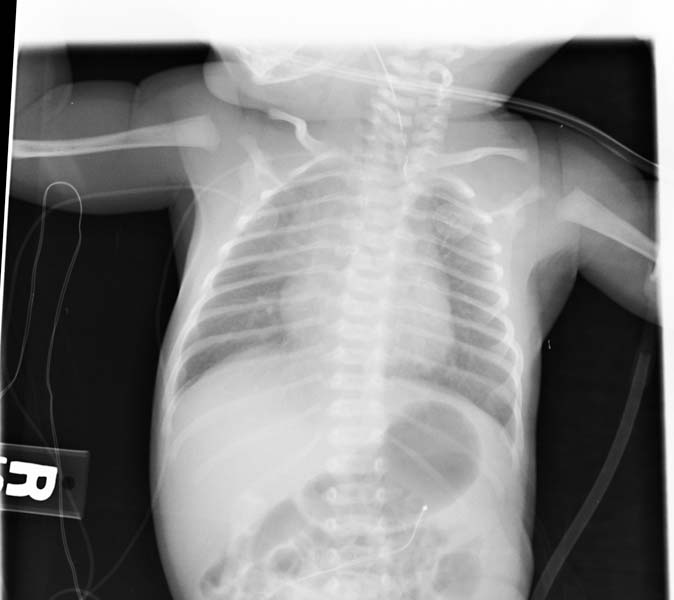Esophageal atresia
| Esophageal atresia | |
| ICD-10 | Q39.0, Q39.1 |
|---|---|
| ICD-9 | 750.3 |
| DiseasesDB | 30035 |
| MeSH | D004933 |
For patient information click here
Editor-In-Chief: C. Michael Gibson, M.S., M.D. [1]
Overview
Esophageal atresia (or Oesophageal atresia) is a congenital medical condition (birth defect) which affects the alimentary tract. It causes the esophagus to end in a blind-ended pouch rather than connecting normally to the stomach.
Incidence
It occurs in approximately 1 in 4425 live births.
Congenital esophageal atresia (EA) represents a failure of the esophagus to develop as a continuous passage. Instead, it ends as a blind pouch. Tracheoesophageal fistula (TEF) represents an abnormal opening between the trachea and esophagus. EA and TEF can occur separately or together. EA and TEF are diagnosed in the ICU at birth and treated immediately.
The presence of EA is suspected in an infant with excessive salivation (drooling) and in a newborn with drooling that is frequently accompanied by choking, coughing and sneezing. When fed, these infants swallow normally but begin to cough and struggle as the fluid returns through the nose and mouth. The infant may become cyanotic (turn bluish due to lack of oxygen) and may stop breathing as the overflow of fluid from the blind pouch is aspirated (sucked into) the trachea. The cyanosis is a result of laryngospasm (a protective mechanism that the body has to prevent aspiration into the trachea). Over time respiratory distress will develop.
If any of the above signs/symptoms are noticed, a catheter is gently passed into the esophagus to check for resistance. If resistance is noted, other studies will be done to confirm the diagnosis. A catheter can be inserted and will show up as white on a regular x-ray film to demonstrate the blind pouch ending. Sometimes a small amount of barium (chalk-like liquid) is placed through the mouth to diagnose the problems.
Treatment of EA and TEF is surgery to repair the defect. If EA or TEF is suspected, all oral feedings are stopped and intravenous fluids are started. The infant will be positioned to help drain secretions and decrease the likelihood of aspiration. Babies with EA may sometimes have other problems. Studies will be done to look at the heart and spine. Sometimes studies are done to look at the kidneys.
Surgery to fix EA is rarely an emergency. Once the baby is in condition for surgery, an incision is made on the side of the chest. The esophagus can usually be sewn together. Following surgery, the baby may be hospitalized for a variable length of time. Care for each infant is individualized. If you have any questions do not hesitate to ask a member of the pediatric surgery team.
Its very commony seen in new born with imperforate_anus.
Types
This condition takes several different forms, often involving one or more fistulas connecting the trachea to the esophagus (tracheoesophageal fistula). Approximately 85% of affected babies will have a 'lower fistula'.
Presentation
This birth defect arises in the fourth fetal week, when the trachea and esophagus should begin to separate from each other.
It can be associated with disorders of the tracheoesophageal septum.[1]
Associations
Other birth defects may co-exist, particularly in the heart, but sometimes also in the anus, spinal column, or kidneys.
Diagnosis
This condition is visible some time shortly before birth on an ultrasound, or it may be detected soon after birth as the affected infant will be unable to swallow its own saliva.
- Radiologic diagnosis of esophageal atresia is made by detecting a blind pouch of the proximal esophagus that is distended with air.
- Radiographic evaluation should always include the abdomen to look for the presence of air in the gastrointestinal tract (distal fistula).
Esophageal atresia with tracheoesophageal fistula
Patient #1
Patient #2
Complications
Any attempt at feeding could cause aspiration pneumonia as the milk collects in the blind pouch and overflows into the trachea and lungs. Furthermore, a fistula between the lower esophagus and trachea may allow stomach acid to flow into the lungs and cause damage. Because of these dangers, the condition must be treated as soon as possible after birth.
Treatment
Treatments for the condition vary depending on its severity. The most immediate and effective treatment in the majority of cases is a surgical repair to close the fistula/s and reconnect the two ends of the esophagus to each other. This is not possible in all cases, since the gap between upper and lower esophageal segments may be too long to bridge. In this situation, a gastrostomy is performed, allowing tube feedings into the stomach through the abdominal wall, and often a cervical esophagostomy will also be done, to allow the saliva which is swallowed to drain out a hole in the neck. Months or years later, the esophagus may be repaired, sometimes by using a segment of bowel brought up into the chest, interposing between the upper and lower segments of esophagus.
Post operative complications sometimes arise, including a leak at the site of closure of the esophagus. Sometimes a stricture, or tight spot, will develop in the esophagus, making it difficult to swallow. This can usually be dilated using medical instruments. In later life, most children with this disorder will have some trouble with either swallowing or heartburn or both.
Associations
It is associated with hydramnios in the third trimester.
External links
- Esophageal Atresia Index
- Description of Esophageal Atresia
- EA/TEF Family Support Connection
- Esophageal atresia with tracheo – esophageal fistula
References
- Harmon C.M., Coran A.G. (1998). Congenital anomalies of the esophagus. In: Pediatric Surgery, 5th edn. St Louis, KY: Elsevier Science Health Science Division. ISBN 0-8151-6518-8.
Template:Congenital malformations and deformations of digestive system




